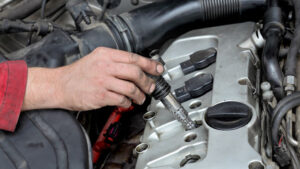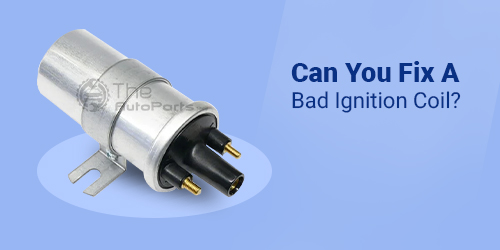Are you facing trouble while starting your car? If your vehicle is unable to give proper levels of grunt and power as it used to give earlier. The ignition coil is the underlying cause that plays a significant role in igniting the air due to the engine’s fuel mixture. Over time this critical car component starts hampering the smooth driving, and it’s time to fix the bad ignition coil rather than leaving the issues unattended.
How Exactly Does an Ignition Coil Work?
The ignition coil is a vital component of the ignition system besides other components, including switch, battery, alternator, and spark plugs. The coil is responsible for converting the 12V charge into 20 to 40V, with which the ignition process is performed.
The ignition coil consists of two windings surrounded by an iron core. Both of them are immersed in oil to help the coil stay cool. Once the power is supplied, the outer coil becomes charged and creates a magnetic field around it. This charge is transferred to the inner coil, which is converted into high voltages required for ignition in the pistons.
Bad Ignition Coil Symptoms

Check the following things, which clearly indicate a bad ignition coil. The mechanic will fix these issues for you. Alternatively, If you have sound knowledge, you can fix these car components on your own:
Misfiring and Stalling
A failing or a problematic ignition coil often makes the pistons misfire, or there is no firing at all. If you have been hearing weird sounds accompanied by the poor response from the engine leading to vibrations or jerks, the ignition coil is the root cause of the problem. In the worst-case scenario, the car might shut down or start stalling as you place your foot on the gas.
Car Not Starting at All
A single ignition coil prevents the car from starting. Despite a properly charged battery, the moment you put the keys inside or press the button, you would hear a clicking sound taking place due to a faulty ignition coil. Not getting enough charge prevents the engine from firing up properly.
Less Miles to the Gallon
In case the engine is unable to burn the fuel, it might need more fuel to perform the same job, ultimately plummeting the fuel levels. A problematic ignition coil leads to oxygen sensor issues and sends more amount of fuel than it actually needs. Adding unused fuel to the engine can damage other parts such as catalytic converter repairing it is a costly affair.
An Illuminating Engine Light
A check engine light starts illuminating due to several reasons; one among them is a faulty ignition coil. In such a case, the mechanic would be performing an OBD-II check on your car. Codes P0300 to P0312 reveal the misfiring issue, while the codes P0350 to P0362 occur due to ignition coil issues.
Backfiring
The fuel economy issue makes the unspent fuel enter the exhaust system. As the fluid comes in contact with the hot metal of exhaust or a catalytic converter, it ignites suddenly, leading to an explosion accompanied by a loud sound dissipated by the car.No matter whether it is a bad ignition coil or something else, get the vehicle inspected from the mechanic.
Oil Leak
The ignition coil generates a lot of current and charge, which generates excess heat from the system. In a normally working part, these issues are generally taken care of by the oil that keeps the system cool. However, a broken coil definitely results in overheating, cracks the housing, and the oil starts coming out of the part.
Bad Spark Plugs

A worn-out spark plug will dissipate more charge from the engine than usual. This would add an excessive amount of strain on the ignition coil that wears out over time. In case of spark plug issues, it is better to check the ignition coil.
Steps to be Taken to Prevent Faulty Coil
Take the following steps to help the ignition coil perform optimally and effectively:
Check Spark Plugs on Regular Basis
Spark Plugs can drain the coil excessively, ultimately resulting in premature degradation. Keep the plugs up to date to prevent ignition coil failure.
Inspect Coil Casing
Ensure that attention is given to the wires connecting the coil to the electrical system to prevent leaks. The wires would become toasted in case the drain issues have taken place.
Regular Maintenance
Ensure that the vehicle undergoes regular maintenance and performs smoothly.
How Much Does Ignition Coil Replacement Cost?
The cost of an ignition coil depends on the make, year, and model of the car. The ignition coil might cost as low as $75, which could rise up to $300.The labor costs are charged separately and would cost up to $150.In case of ignition coil failure, expensive repairs will be burning a hole in your pocket; it is better to get the car part from a trusted store, ‘The Auto Parts Shop,’ and pay the labor charges to the mechanic.
How to Replace Ignition Coils by Yourself?

One can fix a bad ignition coil by himself; all you need to do is follow the step by step process listed as follows:
- As the engine cools, open the hood and disconnect the negative cable from the battery.
- Locate the ignition coil in the car. You can assess certain coils as it is without disassembling the engine. In certain cases, you have to access the intake manifolds to reach the coil.
- Once you’ve found the ignition coils eliminate the plastic electrical connector from the coils and unscrew the bolts that hold the coils at the place.
- As the bolts have been removed, take the coils out of the engine block. Give extra care while taking the ignition coil out; being too rough could pose great damage to the spark plugs.
- The resistance of each coil is generally calibrated using a multimeter. If the resistance is below certain levels, know that it’s a bad ignition coil that needs to be replaced. Check the manual that depicts information about the ignition coil, which is ideal for your car.
- Once you’ve invested in the right ignition coil, it’s time to insert them in the car. Add some dielectric grease within the ignition coil insulator boot and put the new coil back into the spark plug.
- Install the ignition coil bolts again and join the electrical connections again. Assemble the engine manifold again and attach the negative battery to the cable battery.
- Inspect the vehicle via a test drive. If everything works well, then you’ve performed the replacement process properly; otherwise, there is some other issue with the car.
The Bottom Line
Working with a problematic ignition coil could give rise to more issues. Fixing a bad ignition coil isn’t a hassle; you just need to follow the step-by-step process. Resolve the ignition coil problems for the smooth working of the vehicle.
